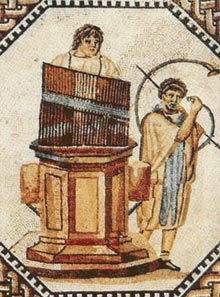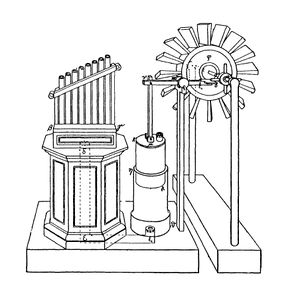Pipe Organs
This article was initially written by Robert Woods, ASME Fellow. This article contains material published in Mechanical Engineering Magazine Apr. 2005. Copyright 2005 American Society of Mechanical Engineers
One of the most popular summer pasttimes is attending a baseball game. Maybe you can hear it now-the crack of the bat, the keyboard fanfare for a base hit - the background music for the summer.
What many fans may not realize, however, is that they are hearing the echo of a sound that originated more than 2,000 years ago. The pipe organ was already centuries old, for instance, when it provided music for the stadia of imperial Rome, where gladiators chased more than baseballs.
The earliest versions of the instrument contained a number of sophisticated pneumatic devices, including pressure regulators, check valves, and piston pumps. Much of the organ has appeared fundamentally unchanged throughout history and is still with us in such different places as churches and baseball diamonds. A present-day designer could come up with pretty much the same thing, but it is remarkable, at least to this present-day engineer, that this piece of plumbing was created two millennia ago.
We know quite a lot about the early days of the pipe organ because it was recognized in ancient times as being a watershed invention. Even the name of its creator, Ctesibius, has come down to the present day. In Alexandria, Egypt, 246 years before the Christian era, he brought together the arts of metalworking and precision fabrication along with a pragmatic knowledge of fluid dynamics.
The organ was mentioned by such classical Roman authors as Cicero, Lucretius, and Petronius, and was well documented by technologists of the time. A publication, De Architectura, written around the time of Christ by a Roman, Vitruvius. included a discussion of the organ. Among the things Vitruvius described are the lathe-turned bronze cylinders and the leather and wood packing of the pistons. Hero of Alexandria also detailed the instrument, around the third century A.D., in a lengthy document called Pneumatica.
Ctesibius's invention shows that when technology becomes ripe, an innovation will always follow. Metalworking had been developed to a high degree, and the tools that were needed to fabricate precise components (mostly wooden, in this case) existed. This hardware was combined with the ancient breath operated musical flute to produce a keyboard instrument in which the musician could command more than one octave and was not limited by his lung power.
His most ingenious contribution, although its use declined after a few centuries because it was cumbersome, was a method of pumping and storing air at a controlled pressure while simultaneously eliminating fluctuations that would cause warbling and pitch changes in a wind instrument. Air was stored in a relatively large plenum chamber immersed in a water bath. Air was pumped in and allowed to bubble out of the bottom at a pressure that was stabilized by the hydrostatic head of water.
The electrical analogy of this system would be a large capacitor with a Zener diode to ground. Air was supplied by a manually operated piston pump that was fitted with a true check valve. This organ was called the "hydraulis" because it involved water. Its operation involved a continuous airflow out of the bell jar, so the sound of bubbling water may have been an integral background to every musical performance.
Two examples of the ancient hydraulis have been excavated. One was discovered in the 1950s at the Roman settlement of Aquincum in Hungary. Another was found in 1992 at an archaeological dig at Dion, a site in northern Greece at the foot of Mount Olympus. The Dion instrument has been studied extensively and a modern replica constructed by the European Cultural Center of Delphi. It has been the subject of a number of publications. George PaJeoyanis of the Cultural Centre has kindly furnished one, a document that was written by Vassilis Karasmanis. He has also provided more information regarding the mechanism. In the United States, Richard Pettigrew of the Archaeology Legacy Institute directs the Archaeology Channel project, which has a Web page describing the hydraulis.
After the decline of Greece, the hydraulis flourished in Rome, where it became a popular instrument at public events. Its volume was adequate to provide background music for gladiatorial contests. It is a little morbid to speculate on what the organist played as an entertaining interlude while men were killing each other.
Except for the substitution of bellows for piston pumps, which was done around the second century A.D., the organ continued essentially unchanged until the end of the Western Roman Empire. After that, the use of organs in the West died out for 200 years, although they survived and flourished in the Eastern, or Byzantine, Empire, whose capital was Constantinople.
In 757, Emperor Constantine V of Byzantium sent one as a gift to Pepin the Short, the king of the Franks, who became the father of another famous historical figure, Charlemagne. That particular instrument was destroyed by fire in the early ninth century and could not immediately be replaced because no one could be found at first who had the necessary technical skills.
It became necessary to seek assistance from the medieval equivalent of the national laboratories. In those days, the monasteries were the great repositories of knowledge. A monk, vvho had seen organs in Constantinople, was the person consulted to rebuild this piece of precision machinery.
The majesty of an organ's sound was recognized by some as a logical complement to worship services. Today we take for granted the presence of organs in churches, but at first the church fathers objected to the introduction of loud music at church services. By 900 A.D., advocates of organ music began to overcome reactionary attitudes, and a bank of pipes had become a well- recognized ecclesiastical fixture by 1400.
The sheer volume of sound and the size of the forests of pipes (more than 50 not being unusual) give a misleading impression of the amount of compressed air needed for an organ's operation. O ur familiarity with the amount of electrical power needed to produce sound with a conventional speaker system leads us to grossly overestimate the amount of power actually getting into the air. Ashton Taylor of Hoover & Keith Inc. points om that even at triple forte an organ is putting fewer than 10 acoustic watts into the air. To develop a real appreciation for the relationship between acoustic power and its effect on the ear one might try listening to the majestic organ passage in Saint-Saens's Third Symphony. The only thing that produces a comparable psychological impact on the listener is a jet taking off with full afterburner. But the organ generates less than 10 watts of acoustic power.
An organ pipe is remarkably effective because it exploits the fact that large amplitude excursions can be induced into a high Q system by a small excitation. Unlike other mechanical systems, a resonant pipe has no lossy interface between a transducer and whatever it is driving. The air itself acts as the working medium. During the "attack," hundreds or even thousands of cycles may be taken to fully develop resonance, thus the exciting force can be infinitesimal. Because of this efficiency, even the largest medieval instruments could be powered by a foot operated bellows pump. Early builders (in some cases, very early indeed) did not understand the aerodynamics, but they accomplished remarkable results by trial and error.
With the exception of some special cases involving reeds, an organ pipe is excited by airflow over a knife edge. This causes the flow to oscillate between two states. The oscillation can have a high harmonic content, one or more components of which excite resonance in the pipe. In recent years, it has been recognized that this usually involves the creation of a von Karman vortex street, but that understanding came later. The pioneers built upon their observations of reed flutes. The aerodynamics has been well explored and is treated in detail in many texts. Physics and Music by H.F. White and D.H. White is a good example.
During the Middle Ages, portable organs called "positives" became popular. They were pumped by a pair of weighted, manually operated bellows, which were alternately lifted and then released. This kept an assistant occupied manipulating bellows while the musician played the instrument. Air was compressed when a bellows collapsed under its own weight. Check valves, usually in the form of leather flaps, prevented crossflow. The presence of a pair of bellows made it possible to deliver an uninterrupted air supply to a moderate-size plenum chamber, the air chest. Such a capacitance replaced the bell jar of the hydraulis as a storage component.
The positive was so familiar that, like the harp, it came to symbolize music itself. In medieval illustrations, the positive is not fundamentally different, except for its pumping arrangement, from pipe organs shown on Roman coins dated 15 centuries earlier. The keys and valves date back unchanged to Ctesibius.
The organ has had a colorful history. Today it is familiar at church services and sporting events. It has been a source of inspiration or a harmless diversion for people in the Middle Ages. It was part of barbaric spectacles in ancient Rome, where it was so common that even Nero, a self- styled patron of the arts, is known to have enjoyed playing one. His musical aspirations may have given rise to the colorful story that he "fiddled" while Rome burned.
The fiddle hadn't been invented yet. It may have been a keyboard.

